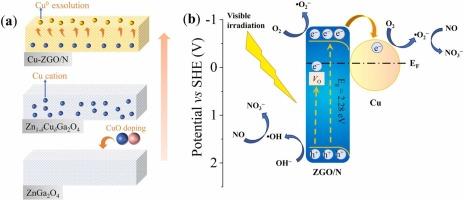cu修饰的氮化氧原位生长优化光催化氧化一氧化氮
IF 11.3
1区 环境科学与生态学
Q1 ENGINEERING, ENVIRONMENTAL
引用次数: 0
摘要
光催化技术为减少环境空气中的低浓度氮氧化物污染物提供了一种前景广阔的绿色策略。通过氨解掺杂 CuO 的 ZnGa2O4 尖晶石,合成了一种蚯蚓状的氧氮化物,其上装饰有原位生长的 Cu 纳米颗粒。优化的形态促进了活性位点的暴露,扩大了反应界面,从而实现了高效的氮氧化物吸附和光催化转化。Cu0 和 N3- 掺杂的装饰作用增强了光吸收,并赋予了可调能带结构。Cu0 与 Ga1-xZnxN1-yOy 界面之间的强相互作用通过促进电荷载流子的转移和抑制电荷载流子的重组,最大限度地利用了光诱导电荷。H2O 和 NO 在 Cu0 上的强吸附性以及 Cu0-Ga1-xZnxN1-yOy 结的内电场有助于实现 NO 的高选择性。这项研究为设计具有肖特基结的可见光驱动光催化剂用于环境修复提供了新的视角。本文章由计算机程序翻译,如有差异,请以英文原文为准。

In situ Growth of Cu0-Modified Oxynitride for Optimized Photocatalytic Nitric Oxide Oxidation
Photocatalysis technology provides a promising and green strategy for the abatement of low-concentration NO pollutants in the ambient air. An earthworm-like oxynitride decorated with in situ grown Cu nanoparticles is synthesized through the ammonolysis of the CuO-doped ZnGa2O4 spinel. The optimized morphology promoted the exposure of active sites and expanded the reaction interface for efficient NO adsorption and photocatalytic conversion. The decoration of Cu0 and N3- doping enhanced the light absorption and imparted a tunable energy band structure. The strong interactions between Cu0 and the Ga1-xZnxN1-yOy interface maximize the utilizing photo-induced charge by facilitating the transfer and inhibiting the recombination of the charge carrier. The strong adsorption of H2O and NO on Cu0 and internal electric field of Cu0-Ga1-xZnxN1-yOy junction contribute to the high selectivity of NO. This study provides a new perspective on the design of visible-light-driven photocatalysts with Schottky junction for environmental remediation.
求助全文
通过发布文献求助,成功后即可免费获取论文全文。
去求助
来源期刊

Journal of Hazardous Materials
工程技术-工程:环境
CiteScore
25.40
自引率
5.90%
发文量
3059
审稿时长
58 days
期刊介绍:
The Journal of Hazardous Materials serves as a global platform for promoting cutting-edge research in the field of Environmental Science and Engineering. Our publication features a wide range of articles, including full-length research papers, review articles, and perspectives, with the aim of enhancing our understanding of the dangers and risks associated with various materials concerning public health and the environment. It is important to note that the term "environmental contaminants" refers specifically to substances that pose hazardous effects through contamination, while excluding those that do not have such impacts on the environment or human health. Moreover, we emphasize the distinction between wastes and hazardous materials in order to provide further clarity on the scope of the journal. We have a keen interest in exploring specific compounds and microbial agents that have adverse effects on the environment.
 求助内容:
求助内容: 应助结果提醒方式:
应助结果提醒方式:


